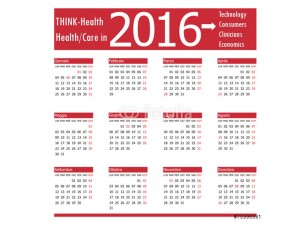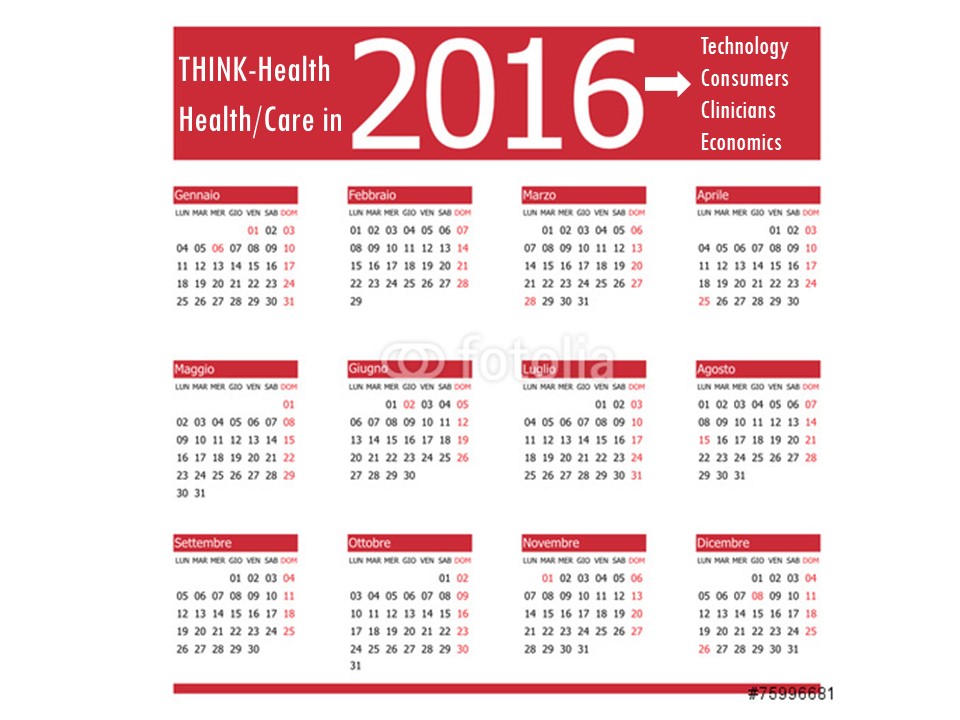
It’s time to get the tea leaves out and mash up trends in my world of health, health care, technology, policy and people for 2016. We’ll start with the central player: people, consumers, patients, caregivers all.
Health consumerism on the rise. People – call us patients, consumers, caregivers – will take on even more financial and clinical decision making risk in 2016. Growing penetration of high-deductible and consumer-driven health plans will push (not just nudge) people into the role of health care consumers, and the emerging businesses and programs serving the transparency market for price and quality will gain traction among folks shopping for health insurance plans, health care services, physicians, prescription drugs, and long-term care, among the many line items patients must pay first-dollar for in the new year.
People get more mindful about financial wellness. Growing out-of-pocket expenses are driving working people to cut investments in 401(K)s and in retirement plans. More workers are getting more aware of the health money-mind-body connection. Stress begets ill-health. Mindful health care consumers will adopt strategies to help manage financial wellness, some offered by employee wellness plans (like meditation) and some available through wearable tech (see below).
Retail health grows. The pharmacy isn’t ‘just’ a dispenser of prescription drugs anymore; not even close. CVS/Health, Walgreens (acquiring Rite-Aid), grocery chain pharmacies, Target and the almighty Walmart will keep growing their health and wellness aisles and shelf space, along with more healthcare services through licensed professionals in the pharmacy area. Health and beauty and over-the-counter drug products will help consumers manage their health savings account outflows, as people say “no” to prescription drugs in many cases, choosing to project manage their health more with OTCs, food, and lifestyle choices.
More consumers make tough, dollar-saving prescription decisions based on cost. With the advent of the $100,000 a year therapy (which I coined as “Supersized Drug Therapy”), consumers’ financial risk-sharing can be 50% or more in a coinsurance-designed Rx benefit plan, or first-dollar in a high-deductible plan. In 2016, more consumers will be more outspoken in media, both traditional and social, echoing the Bitter Pill arguments of Steven Brill’s seminal TIME magazine piece. We’ll see the American Hospital Association and AHIP (the insurance industry advocacy group) organize arguments against PhRMA, the pharmaceutical industry’s lobby, further putting prescription drug costs in the macroeconomic (national, for Medicare and Medicaid) and microeconomic (for individuals and families) bulls-eyes. Expect Congress to be discussing the topic of Rx costs throughout 2016, and for this health issue to be part of the 2016 Presidential race talking points.
Food = health for a majority of consumers. 80% of consumers walking into a grocery store look for health inside the products on the store shelves, say the market researchers who study food shoppers. Expect the health/food connection to be top-of-mind for people looking to bolster health and to stay out of the healthcare system for as long as they can. Food manufacturers, Big Food and smaller artisanal firms, are all looking at health (we know this from our own portfolio of work at THINK-Health, which is growing in this segment).
Employers will continue to stay in the health care game….for another year or two. For now, expect larger employers who provide health insurance to continue to do so, albeit changing lanes toward consumer-directed plans and HDHPs. Smaller shops keen on health care will migrate workers toward health insurance exchanges. The Cadillac Tax ruling solidifies this forecast point…again, for the near-term.
More people-patients will dig into the information in EHRs. Too few patients have engaged with patient portals in 2015, and haven’t been welcomed to do so by their health care providers who have other priorities. In 2016, more patients will do so, again as part of connecting the dots as health care consumers to manage their (clinical) numbers and health care finances.
Health providers will dip into the world of wearable tech for patients. As more providers take on value-based payment for health care services, and patients themselves adopt digital health tools (e.g., Fitbit devices and Apple Watches), clinicians will recommend or “prescribe” wearable technologies to help patients become more mindful about medication adherence, activity tracking, blood sugar measurement, and weighing on a regular basis. Activities of daily living are key to bolstering health for people managing chronic conditions, and a small minority of providers will begin to take in these data points when taking on population health responsibilities. Clinicians will also crowdsource more their recommendations for what works in their patient populations, curating mobile health apps and tools that demonstrate sustained user by people over time, and efficacy.
CES2016 will dramatically expand digital health offerings toward healthcare. Next week at the 2016 Consumer Electronics Show, we’ll see more digital health products focusing more on clinical issues for people who are not well and fit. While there will continue to be a lot of buzz around shiny new things for athletes and quantified self-ers, some companies are getting more realistic about the mass middle of consumers who manage chronic conditions, thick waistlines, and tight budgets. Remote health monitoring solutions, Internet of Things providers, and wearable tech companies who are mature in the space will be talking more about being part of the solution for managing health care costs and conditions. There will be many more heart-focused sensors, for example; I’ve also receive invitations to kick tires for devices “reading” hemoglobin levels, blood glucose, and other clinical metrics. Fitbit has been discussing plans in this direction, and as the largest player in the wearable health-tech segment, this is a heads-up. (Stay tuned to Health Populi and my twitter handle @HealthyThinker to stay in touch with my learnings and perspectives all next week in Las Vegas at #CES2016).
Health Populi’s Hot Points: For THINK-Health, through our broad lens, health is everywhere — not confined on Pill Hill, in a doctor’s exam room, or in a lab test (although all of these health care services are important in the right patient at the right time and the right ‘dose’). As value-based payment grows, people take on more consumer shopping behaviors, and stakeholders in health/care adopt Triple Aim principles, there will be greater recognition that health is everywhere, and public health has a solid ROI. See this video from the American Public Health Association for an explanation of this Holy Grail viewpoint.
[youtube https://www.youtube.com/watch?v=B5M9JefYxJI?rel=0]
Wishing Health Populi readers and the people you love a healthy, joyful, peace-ful New Year in 2016!





 I am so grateful to Tom Lawry for asking me to pen the foreword for his book, Health Care Nation,
I am so grateful to Tom Lawry for asking me to pen the foreword for his book, Health Care Nation,  I love sharing perspectives on what's shaping the future of health care, and appreciate the opportunity to be collaborating once again with Duke Corporate Education and a global client on 6th May. We'll be addressing some key pillars to consider in scenario planning such as growing consumerism in health care, technology (from AI to telehealth), climate change, and trust -- the key enabler for health engagement or dis-engagement and mis-information. I'm grateful to be affiliated with the corporate education provider
I love sharing perspectives on what's shaping the future of health care, and appreciate the opportunity to be collaborating once again with Duke Corporate Education and a global client on 6th May. We'll be addressing some key pillars to consider in scenario planning such as growing consumerism in health care, technology (from AI to telehealth), climate change, and trust -- the key enabler for health engagement or dis-engagement and mis-information. I'm grateful to be affiliated with the corporate education provider  Thank you FeedSpot for
Thank you FeedSpot for